Moles Getting Darker: Essential Guide to Identification and Precautions
What causes moles to darken. How to identify potentially dangerous moles. When should you consult a doctor about changes in your moles. What are the ABCDEs of melanoma. How are suspicious moles removed.
Understanding Mole Types and Their Characteristics
Moles are pigmented spots on the skin that come in various shapes, sizes, and colors. They can be raised or flat and are primarily determined by genetics. However, environmental factors like sun exposure and tanning bed use can influence their appearance and formation. Let’s explore the main types of moles:
- Congenital moles: Present at birth, categorized by size (small, medium, large)
- Acquired moles: Develop after birth, typically smaller than a pencil eraser
- Atypical moles (dysplastic nevi): Asymmetrical with irregular borders and multiple colors
What sets congenital moles apart? Only large congenital moles (greater than 20mm) have a significantly increased risk of developing into skin cancer. Acquired moles, on the other hand, are generally considered low-risk. Atypical moles require closer monitoring, as multiple atypical moles can indicate a higher risk of skin cancer.

The ABCDEs of Melanoma: A Crucial Self-Examination Guide
Regular self-examination of your moles is essential for early detection of potential skin cancer. The ABCDE method is a valuable tool for identifying suspicious moles:
- A – Asymmetry: One half of the mole doesn’t match the other
- B – Border: Irregular, scalloped, or poorly defined edges
- C – Color: Varied shades within the same mole (black, brown, white, red, blue)
- D – Diameter: Larger than 6mm (about the size of a pencil eraser)
- E – Evolving: Changes in size, shape, or color over time
How often should you examine your moles? Experts recommend checking your skin every one to two months. This frequency allows you to detect any new moles or changes in existing ones promptly.
Factors Influencing Mole Changes: When Darkening is Normal
While sudden changes in moles can be concerning, certain life stages and conditions can cause normal darkening:
- Puberty: Hormonal changes can affect mole appearance
- Pregnancy: Increased hormone levels may cause moles to darken
- Sun exposure: UV radiation can intensify mole pigmentation
- Aging: Natural changes in skin can alter mole color over time
When is mole darkening a cause for concern? If a mole darkens rapidly, unevenly, or is accompanied by other changes like itching or bleeding, it’s time to consult a dermatologist.
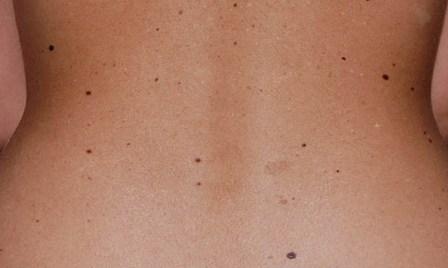
The Impact of Sun Exposure on Mole Formation and Darkening
Sun exposure plays a significant role in mole development and changes. How does UV radiation affect moles?
- Stimulates melanocyte activity, leading to increased pigmentation
- Can cause the formation of new moles
- May accelerate the growth of existing moles
- Increases the risk of atypical mole development
To protect your moles from harmful UV rays, always use broad-spectrum sunscreen with a high SPF, wear protective clothing, and limit sun exposure during peak hours.
When to Seek Medical Attention: Red Flags for Mole Changes
Certain mole changes warrant immediate medical attention. What are the key warning signs?
- Rapid growth or expansion
- Sudden onset of itching or pain
- Bleeding or oozing without injury
- Development of a new mole after age 30
- Changes in texture (becoming rough, scaly, or ulcerated)
If you notice any of these changes, don’t hesitate to consult a dermatologist. Early detection and treatment of potentially cancerous moles can be life-saving.

The Importance of Regular Skin Checks
Regular skin checks by a dermatologist are crucial, especially for individuals with:
- A family history of skin cancer
- Numerous moles (more than 50)
- A history of severe sunburns
- Fair skin or light-colored eyes
- A weakened immune system
How often should high-risk individuals have professional skin checks? Most dermatologists recommend annual full-body examinations, but those with multiple risk factors may benefit from more frequent visits.
The Mole Removal Process: What to Expect
If a mole is deemed suspicious or bothersome, your dermatologist may recommend removal. What does the mole removal process entail?
- Local anesthesia is administered to numb the area
- The mole is removed using one of two methods:
- Shave excision: The mole is shaved off flush with the skin
- Surgical excision: The entire mole is cut out, and the wound is closed with stitches
- The removed tissue is sent to a laboratory for analysis
- Results are typically available within 1-2 weeks
Is mole removal painful? Most patients experience minimal discomfort during and after the procedure. Your dermatologist will provide aftercare instructions to ensure proper healing.

Post-Removal Care and Monitoring
After mole removal, proper care is essential for optimal healing and to minimize scarring. What are the key post-removal care tips?
- Keep the area clean and dry
- Apply antibiotic ointment as directed
- Avoid sun exposure to the treated area
- Watch for signs of infection (redness, swelling, pus)
- Follow up with your dermatologist as scheduled
How long does it take for the removal site to heal? Most mole removal sites heal within 2-3 weeks, but complete healing and fading of any residual marks can take several months.
Advances in Mole Monitoring Technology
Recent technological advancements have revolutionized mole monitoring and early skin cancer detection. What are some cutting-edge tools used by dermatologists?
- Digital dermoscopy: High-resolution imaging for detailed mole analysis
- Artificial intelligence (AI) algorithms: Assist in identifying potentially cancerous lesions
- 3D total body photography: Creates a comprehensive map of a patient’s moles for precise tracking over time
- Confocal microscopy: Provides non-invasive “optical biopsies” of suspicious moles
How do these technologies benefit patients? They allow for more accurate and earlier detection of problematic moles, potentially reducing the need for unnecessary biopsies and improving overall skin cancer outcomes.
![]()
The Future of Mole Monitoring: At-Home Devices and Apps
As technology advances, at-home mole monitoring tools are becoming increasingly sophisticated. What options are available for consumers?
- Smartphone apps with AI capabilities for mole analysis
- Handheld dermoscopy devices for personal use
- Wearable UV sensors to track sun exposure
- Telemedicine platforms for remote dermatologist consultations
While these tools can be helpful for regular self-monitoring, it’s important to note that they should not replace professional medical advice and examinations.
Lifestyle Factors Affecting Mole Health and Appearance
Various lifestyle factors can influence the health and appearance of your moles. What are some key considerations?
- Diet: Antioxidant-rich foods may help protect skin cells from damage
- Hydration: Proper skin hydration supports overall skin health
- Stress management: Chronic stress can affect immune function and skin health
- Sleep: Adequate sleep is crucial for skin repair and regeneration
- Exercise: Promotes healthy circulation and overall skin health
How can you incorporate mole-friendly habits into your daily routine? Focus on a balanced diet rich in fruits and vegetables, stay hydrated, practice stress-reduction techniques, prioritize sleep, and maintain regular physical activity.

The Role of Skincare in Mole Management
A proper skincare routine can support overall skin health and potentially influence mole appearance. What skincare practices should you consider?
- Gentle cleansing to avoid irritation
- Regular exfoliation to promote cell turnover
- Use of antioxidant serums to protect against free radical damage
- Daily application of broad-spectrum sunscreen
- Moisturizing to maintain skin barrier function
Can skincare products directly affect moles? While skincare products cannot change the fundamental nature of moles, maintaining healthy skin can create an environment less conducive to abnormal cell growth and may help in early detection of changes.
Genetic Factors and Mole Prevalence: Understanding Your Risk
Genetics play a significant role in determining an individual’s mole count and characteristics. What genetic factors influence mole development?
- Family history of atypical moles or melanoma
- Specific gene mutations (e.g., CDKN2A, CDK4)
- Skin type and pigmentation genes
- Inheritance of certain syndromes (e.g., dysplastic nevus syndrome)
How does understanding your genetic risk impact mole management? Individuals with a higher genetic predisposition to atypical moles or melanoma may benefit from more frequent dermatological check-ups and should be particularly vigilant about sun protection and self-examinations.

Genetic Testing for Melanoma Risk
Advances in genetic testing have made it possible to assess an individual’s risk for melanoma based on their genetic profile. What does genetic testing for melanoma risk involve?
- Analysis of specific genes associated with increased melanoma risk
- Evaluation of family history and personal risk factors
- Consultation with a genetic counselor to interpret results
- Development of a personalized skin cancer prevention and monitoring plan
Is genetic testing for melanoma risk recommended for everyone? While it can be informative, genetic testing is typically reserved for individuals with a strong family history of melanoma or those with multiple atypical moles. Always consult with a healthcare professional to determine if genetic testing is appropriate for your situation.
The Psychological Impact of Atypical Moles and Skin Cancer Risk
Living with atypical moles or an increased risk of skin cancer can have significant psychological effects. What are some common emotional challenges faced by individuals in this situation?

- Anxiety about potential skin cancer development
- Body image concerns related to numerous or atypical moles
- Stress associated with frequent medical check-ups and self-examinations
- Fear of sun exposure and its impact on daily activities
- Feelings of vulnerability or loss of control over one’s health
How can individuals cope with these psychological challenges? Seeking support from mental health professionals, joining support groups, practicing mindfulness techniques, and maintaining open communication with healthcare providers can all be beneficial strategies.
Building a Support System for Mole Monitoring and Skin Health
Creating a strong support system is crucial for maintaining physical and emotional well-being when dealing with atypical moles or increased skin cancer risk. What elements should be included in an effective support system?
- A trusted dermatologist for regular check-ups and consultations
- Family members or friends who can assist with full-body skin checks
- Online or in-person support groups for individuals with similar concerns
- A mental health professional to address anxiety or stress related to skin health
- Educational resources to stay informed about the latest developments in mole monitoring and skin cancer prevention
How can you involve your support system in your mole monitoring routine? Consider bringing a trusted friend or family member to dermatology appointments, sharing educational materials with loved ones, and encouraging open discussions about skin health within your social circle.

What to Look For and When to Worry
Keywords
Kevin Dahle, MD
Moles are mostly determined by genetics, though sun exposure and tanning bed use can cause you to form new moles or make your existing moles darker. Moles may also change during puberty and pregnancy, as well.
Moles are generally small, pigmented spots on the skin. Moles come in many shapes, sizes and colors. Moles can be raised off the skin or flat. There is a huge variety in the types of moles that a person can have. Moles are classified generally into the following categories:
Moles can be raised off the skin or flat. There is a huge variety in the types of moles that a person can have. Moles are classified generally into the following categories:
- Congenital moles. Moles that are present at birth are called congenital moles. Congenital moles are categorized by their size: small, medium and large. Only large congenital moles (greater than 20mm in size) have a significantly increased risk of turning into a skin cancer.
- Acquired moles. Most moles are acquired, meaning they develop after birth. They are typically smaller than a pencil eraser and have even pigmentation and a symmetrical border. Most acquired moles will not develop into a skin cancer.
- Atypical moles. Atypical moles (also called dysplastic nevi) have asymmetrical, irregular borders and often have multiple colors. The pigmentation is often uneven and they can have focal darker areas. Multiple atypical moles can run in families.
 The more atypical moles that you have, the higher your risk of skin cancer.
The more atypical moles that you have, the higher your risk of skin cancer.
When to See Your Doctor About Your Mole
It is important to consult your doctor about any suspicious moles, as these lesions may represent malignant melanoma, a life-threatening type of skin cancer
Examine your skin every month or two to look for any new or changing moles. If you have a family history of atypical moles or skin cancer or you have numerous moles, you may benefit from seeing a dermatologist for regular skin checks.
When you examine your moles, remember the ABCDEs of melanoma. If you notice any of the following, consult your doctor or dermatologist:
A for asymmetry: A mole in which one half of the mole does not look like the other half
B for irregular border: A mole with a poorly defined or scalloped border
C for varied color: A mole with multiple shades of black, brown, white, red and/or blue
D for large diameter: A mole that is larger than a pencil eraser in size
E for evolving: A mole that is changing in size, shape or color
New moles: A new mole that develops, especially if it appears after your 30s
Bothersome moles: A mole that bleeds, itches or is painful
Removing a Mole
Most moles are harmless. However, if your dermatologist is concerned about one of your moles or you want a mole removed, this can usually be done easily in the clinic.
However, if your dermatologist is concerned about one of your moles or you want a mole removed, this can usually be done easily in the clinic.
To remove a mole, your dermatologist will numb the area around the mole and shave or cut it off. Sometimes a few stitches are required. The tissue will be sent to a laboratory to confirm it is not cancerous.
Keep an eye on your moles. The earlier a skin cancer is detected, the easier it is to be treated.
LiVe Well
Dermatology,
Intermountain Healthcare,
Skin Cancer
Last Updated:
4/20/2020
-
LiVe Well
-
LiVe Well
Copyright ©2023, Intermountain Health, All rights reserved.
\n
\n
New moles: A new mole that develops, especially if it appears after your 30s
\n
Bothersome moles: A mole that bleeds, itches or is painful
\n
\n
\n
\n\nRemoving a Mole
\n
\n
Most moles are harmless. However, if your dermatologist is concerned about one of your moles or you want a mole removed, this can usually be done easily in the clinic.
\n
To remove a mole, your dermatologist will numb the area around the mole and shave or cut it off. Sometimes a few stitches are required. The tissue will be sent to a laboratory to confirm it is not cancerous.
\n
Keep an eye on your moles. The earlier a skin cancer is detected, the easier it is to be treated.
\n
The Truth About Mole Changes & Skin Cancer | Henry Ford Health
Warmer weather and longer days are on their way in Michigan, and with the changing season comes more time spent outdoors in summer attire and more sun – which is accompanied by ultraviolet (UV) rays.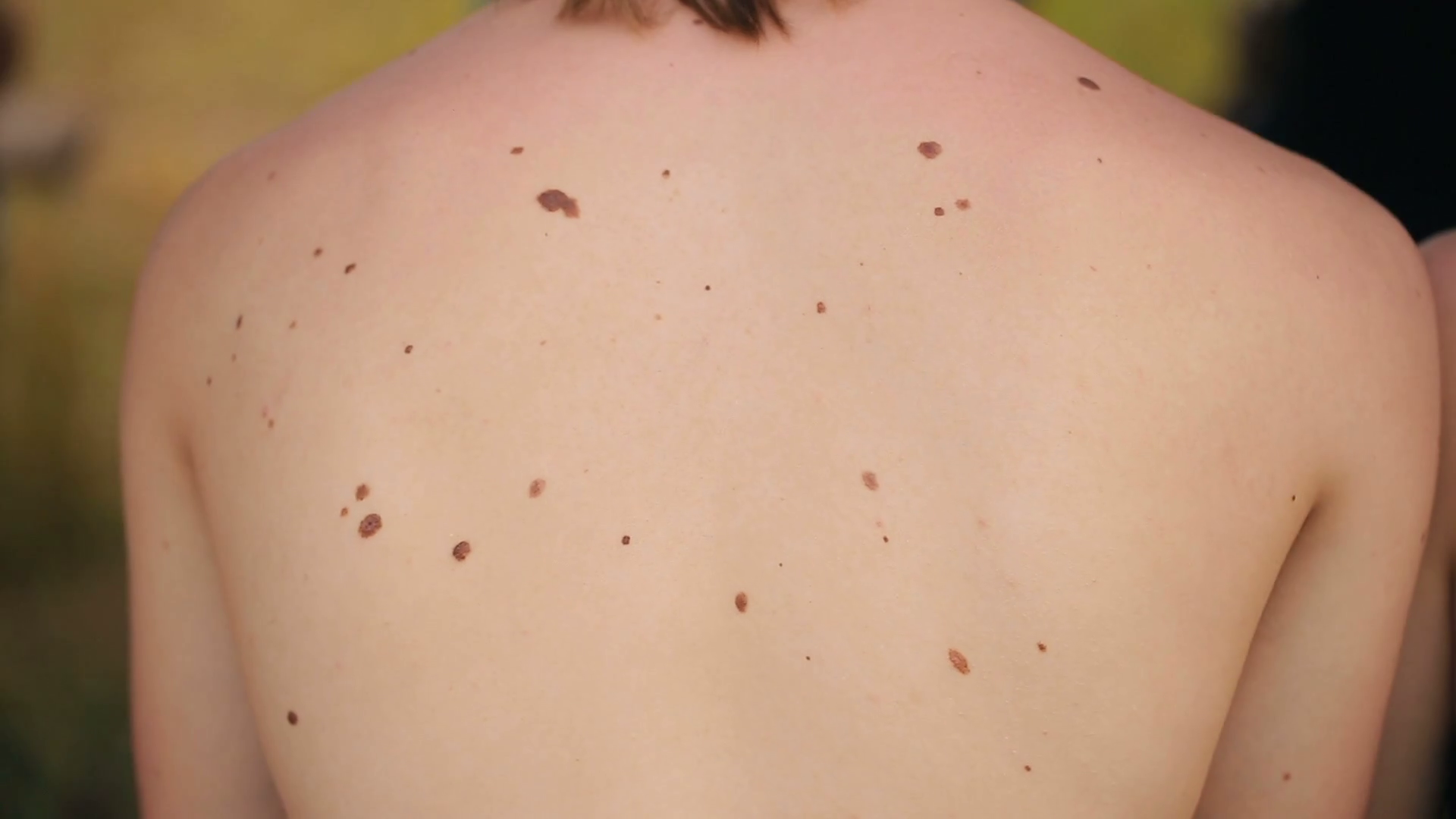 Whether you have one mole or 100, it’s crucial you are aware of the proper shape and color these marks should have – and what to do if you notice changes.
Whether you have one mole or 100, it’s crucial you are aware of the proper shape and color these marks should have – and what to do if you notice changes.
Regardless of the number and appearance of your moles, they are common. And they do change over the course of their lifetime. But how do you know if these changes are healthy and normal or indicate something worse – like skin cancer?
Laurie Kohen M.D., a dermatologist at Henry Ford Health, works with high-risk patients who have numerous irregular moles, and is an expert in assessing if a mole is suspect.
What exactly is a mole?
A melanocyte (mole) is a specific type of pigment-producing cell that resides in the skin. These melanocytes are found periodically in “normal” skin, but can grow in nests to form moles.
Wherever there is skin, a mole can form – meaning they can develop in even inconspicuous places, like under your nails and on the scalp.
Is it normal for moles to change over time?
Short answer: Yes.
“There are normal changes that can occur in moles,” Kohen says. “For example, moles on the face can start out as brown patches, and over time as we grow older, these moles can raise up, lose color and simply become flesh-colored bumps.”
Moles can lighten or darken in color, and raise or flatten. Sometimes, moles can even disappear altogether.
Environmental factors we’re exposed to on a daily basis, like UV light from the sun or indoor tanning and radiation — and even certain medications — can make moles more likely to develop changes or irregularities.
What changes should you look out for?
There are a few indications that a change in your moles could be concerning, Dr. Kohen says.
First, if a mole has multiple colors in it, it could be cause for concern.
“If you have a mole that started out as brown in color and suddenly has black or red (or both) in it, you should get it checked out by your dermatologist,” she says.
If you notice moles that are spontaneously bleeding, this could be another sign that something isn’t right. But before you jump to conclusions – this bleeding could simply be caused by accidental scratching or a mole getting caught on clothing, too. However, it’s best to get a professional evaluation.
But before you jump to conclusions – this bleeding could simply be caused by accidental scratching or a mole getting caught on clothing, too. However, it’s best to get a professional evaluation.
In addition, if you notice your moles are continuing to grow into adulthood, you should see a specialist.
“Moles in children and teens continue to grow in proportion to the person, but at some point that growth should stop,” Kohen says. “If you notice a mole that looks like it’s getting bigger, especially as an adult in your 40’s and 50’s, you should have it checked out.”
Furthermore, developing new moles after age 50 is rare. If you notice new moles appearing on the skin, talk with your dermatologist.
What are the best ways to protect my skin and moles?
You’ve heard it before: The number one protector is sunscreen. Wearing SPF 30 or higher, and re-applying every 2-3 hours is crucial for protecting against skin cancer. But did you know that UV rays can reach our skin even if we are wearing long sleeves and pants?
Choosing photo protective clothing with Ultraviolet Protection Factor (UPF) 50 or higher will protect your non-exposed skin from these harmful rays.
“It’s important to remember that melanoma – the most dangerous form of skin cancer – runs in families, so it’s extremely necessary to protect yourself especially if you have a family history of skin cancer,” Kohen says. “Wear enough sunscreen, reapply when necessary and keep tabs on your moles. If you notice changes, check in with your doctor or dermatologist.”
Have concerns about the appearance of your moles? Overdue for a skin cancer screening? Schedule an appointment with a dermatologist by calling 1-800-HENRYFORD (436-7936) or visiting henryford.com.
Dr. Laurie Kohen is a dermatologist who sees patients at Henry Ford Medical Center – New Center One and Henry Ford Medical Center – Troy.
How to recognize dangerous moles in time
What skin neoplasms in most cases turn into a malignant tumor, why this happens and how to save your life.
Melanoma is the most dangerous skin cancer. Under different guises, she is born from a nevus (mole, birthmark). In the process of development, the tumor rapidly grows through the skin, then, by lymph and blood, it is transferred to other organs. There, new foci appear. The result is death. None of the patients with late-detected melanoma passed the five-year survival limit. Elena Ivannikova, head physician of the Nadzha clinic, tells how to use the life-giving sun rays correctly.
In the process of development, the tumor rapidly grows through the skin, then, by lymph and blood, it is transferred to other organs. There, new foci appear. The result is death. None of the patients with late-detected melanoma passed the five-year survival limit. Elena Ivannikova, head physician of the Nadzha clinic, tells how to use the life-giving sun rays correctly.
– Elena Nikolaevna, everyone knows that the sun is the basis of life, it gives us strength. Warm days have come and the northerners, hungry for the revitalizing rays of the sun, are taking sun baths. Tell me, maybe the talk about the insecurity of spending time on the beach is greatly exaggerated?
– Of course, in moderate doses, sunlight gives us not only joy and good mood, but also health. It is also a good preventive and therapeutic agent for rickets, stimulates the production of vitamin D, strengthens the immune system, and is beneficial in some chronic skin diseases. Ultraviolet for 10-15 minutes a day is useful.
However, the danger to health lies in excessive solar radiation. And thermal burns, heat strokes, high blood pressure and photoaging are not the biggest problem.
According to the Moscow Scientific Research Institute of Oncology. P. A. Herzen, in the 21st century, the incidence of melanoma in Russia has increased and continues to grow. The incidence of melanoma ranks third among all cancer incidence in Russia. On the first and second lines are lung cancer and breast cancer in women. Meanwhile, this type of skin cancer is often the reverse side of a beautiful tan.
— Now many people know that skin cancer can grow from a particular mole. How to distinguish such a dangerous mole?
There are no people without moles. If a mole suddenly changes shape, becomes asymmetrical, has jagged edges, is mottled, or turns black, show it to your doctor. If she began to hurt, itch or bleed – this is also a cause for concern. During life, nevi change during life.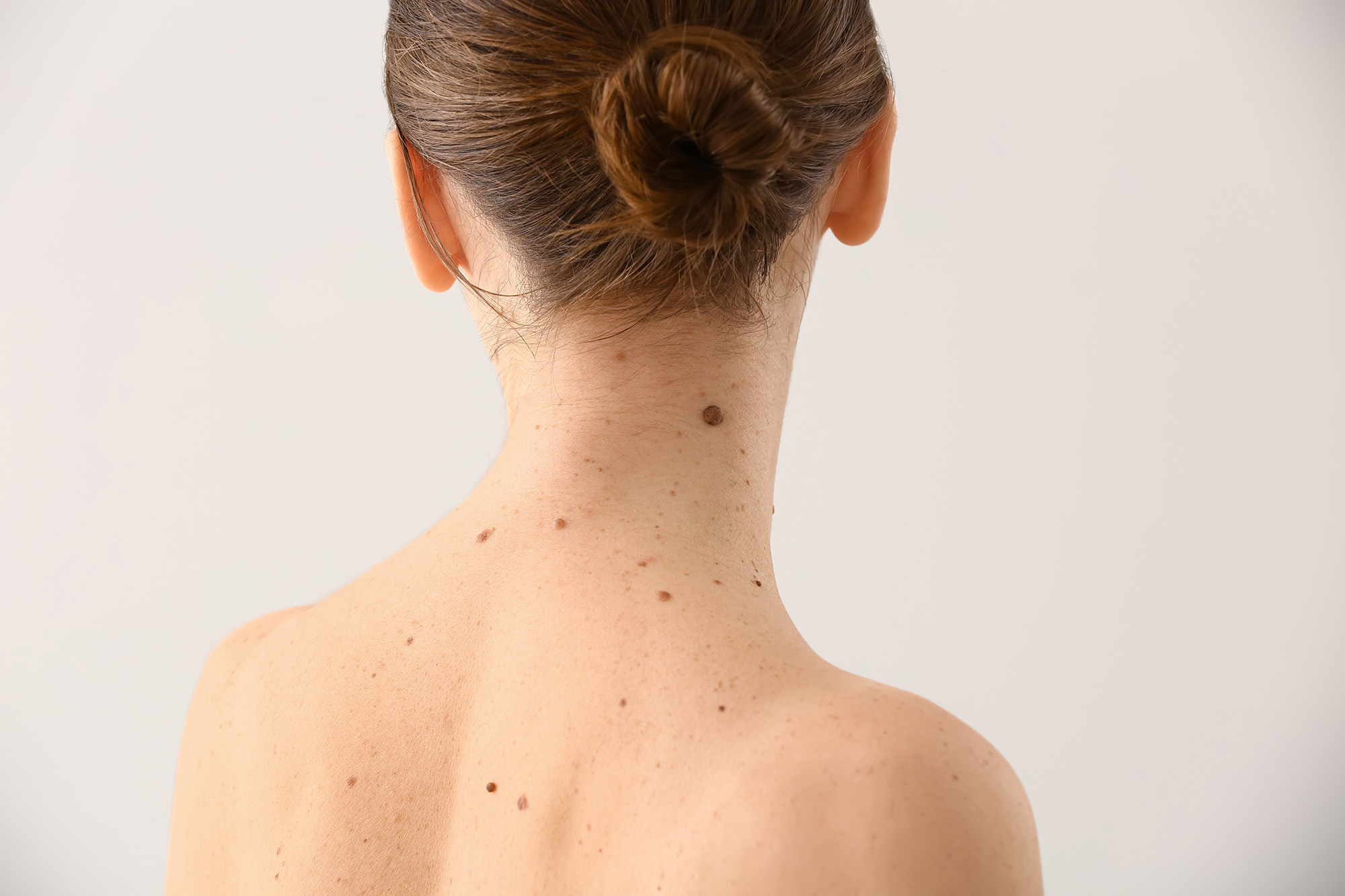 If a nevus appeared in childhood and at the age of 30-40 it has not changed, you should show it to the doctor.
If a nevus appeared in childhood and at the age of 30-40 it has not changed, you should show it to the doctor.
A harmless spot is distinguished from melanoma by five signs that are encrypted in the word “ACORD”:
- A is asymmetry. With an imaginary axis, a safe mole will be divided into two identical parts.
- K – edge, normally smooth and even.
- Oh, coloring. There shouldn’t be any bitterness.
- R is the size. If the mole is larger than 5 mm, observe carefully. The danger increases if it is located on an open area of the body.
- D – dynamics. If there are wounds, an increase in size and other changes, consult a doctor.
The presence of hair in a mole rather speaks of good quality, but if their loss is suddenly noted, it is worth hurrying to a dermatologist – an oncologist.
In men, “bad” nevi are more often localized on the back. The women are on their feet. Moles located on the palms, feet and in places of friction with shoes and clothes are dangerous.
— What is the most common cause of a mole turning into cancer? And who is more at risk of getting sick?
– A pigmented formation can become cancer after an injury or a sunburn of radiation. The presence of such a terrible diagnosis in relatives increases the risk.
Moles turn into a tumor, under the influence of ultraviolet light, in those who have:
- light skin (weak adaptation)
- bright eyes
- blonde and red hair
- many moles (over 50) and freckles
- elderly age.
The risk of getting melanoma in adulthood increases in those who burned under the sun in childhood or more than three times during their lives.
— How to stop melanoma?
“Everyone should be oncologically vigilant about themselves.
Protect exposed skin from the sun. Once every 3-6 months, examine the moles with the help of mirrors and a camera, remember their appearance. If suspicious moles are found, immediately contact a dermatologist to examine the formation using dermatoscopy.
If suspicious moles are found, immediately contact a dermatologist to examine the formation using dermatoscopy.
A dermatoscope is an optical device that magnifies the image tenfold. The doctor examines the mole with the help of this optics and assesses the degree of danger. And in its conclusion gives recommendations for treatment or removal. The study is non-traumatic. Safely. It is carried out within 10-15 minutes. Timely dermoscopic examination of moles and detection of melanoma at an early stage in most cases help to prevent further development of the tumor and save human life.
— Doctors do not recommend sunbathing from noon to 4 pm. But the northern sun is not as active as the southern one. Perhaps you will give more specific recommendations for our readers?
“Our fellow citizens joke that June is not yet summer in our city, August is no longer summer, and July is as lucky. Indeed, sunny days in our region do not happen as often as we would like, but there are no concessions for us. Sun exposure during peak hours should be avoided.
Sun exposure during peak hours should be avoided.
– Elena Nikolaevna, I know that you worked as a dermatologist for many years. Your spouse is also a doctor. Does your family like to sunbathe? Tell me, probably, you don’t allow your children to sunbathe and avoid beach holidays?
– Not at all. After all, we are ordinary people. Sometimes, like everyone else, we rest in the south. But never forget about protection. Being in the sun, we put on hats with wide brim or “visors”, sunglasses, light light clothes made from natural materials. We do not visit the beach from 11.00 to 16.00. And if you happen to spend time on the beach, then we apply protective agents to open areas of the skin. And children from childhood know the rules of caring for their health. Therefore, they are rather surprised why so many people neglect the simple rules of being on the beach.
— What should be the signal to understand that it is worth hiding in the shadows?
– Any change in normal well-being is a reason to stop sun exposure and seek medical help.
– Pharmacy counters, like television advertising, are full of a large number of skin protection products from UV rays. How to choose the right product that is suitable for your skin?
– It is better to use sunscreens that contain both UVA and UVB filters. In the first days, it is necessary to select a filter that will protect the skin as much as possible from the harmful effects of the sun (SPF 90+, 60+, 50+). Next, choose a sun protection factor that matches your skin type (SPF 30+, 15+).
Remember to apply the product 30 minutes before sun exposure and additionally during prolonged sun exposure, as well as after bathing and drying.
The SPF number does not indicate the quality of protection, but the time that you can stay in the sun without burning.
I would like to add that a reasonable attitude to the sun preserves not only health, but also youthfulness of the skin. After all, skin aging in 80% of cases is premature aging (photoaging). Intensive sunburn is a damaging factor for the skin, leads to dehydration,
Intensive sunburn is a damaging factor for the skin, leads to dehydration,
coarsening, loss of elasticity and the appearance of spots, which are not easy to get rid of later.
Basic rules for the prevention of skin cancer:
- don’t be a tanner
- always protect your skin from the active sun
- do not injure moles
- visit a dermatologist-oncologist once a year
- Examine and remove suspicious skin lesions as directed by your doctor.
Healthy skin is a sign of beauty, take care of it and monitor its condition!
Moles: is it worth it to be afraid?
Almost everyone has some number of moles that usually appear in childhood and adolescence.
Almost everyone has some number of moles that usually appear during childhood and adolescence. The medical name is nevus (naevus maternus), a malformation of the skin, in which certain parts of it differ in color and / or a special warty appearance of the surface.
Many skin and subcutaneous neoplasms are quite common, and a careful examination by an oncologist is sufficient for a preliminary diagnosis. Most skin tumors are benign, but malignant tumors are also not uncommon, so early and accurate diagnosis is extremely important.
To provoke a mole to rebirth, of course, a push, an irritant is needed. The strongest irritant of all possible is excessive exposure to the sun.
Ultraviolet irradiation in high doses causes irreversible changes in skin cells, greatly increasing the risk of their degeneration. For each person, the critical amount of insolation is purely individual. It is not easy to determine this line, so it is better to just remember that prolonged exposure to the sun is harmful to the body. The skin is forced to protect itself from ultraviolet radiation. Excessive tanning is inevitable burns that “hit” the skin’s immunity.
The second most common cause of tumor development is injury to a mole. Therefore, if you touched it with your fingernail, inadvertently damaged it with a washcloth, with some sharp object, especially if these injuries are permanent (for example, from underwear), be sure to see a doctor. Teach your children from childhood to take care of small marks on the skin.
Teach your children from childhood to take care of small marks on the skin.
Because birthmarks are very common and melanomas are rare, prophylactic mole removal is not warranted. Look at the mole at an angle, take a magnifying glass: a uniform color, a smooth edge, a transition of the “skin pattern” from an area with a normal color to a pigmented area, the presence of hair is a good sign.
However, if the mole suddenly increases in size (especially if there are uneven edges), darkens, becomes inflamed, becomes mottled, starts to bleed, ulcerates, itches or hurts, the “lacquer” surface of the mole, the special pattern of the edge – alarm!
Having found possible signs of degeneration of a mole, be sure to consult an oncologist.
It is important to remember that all removed moles are subject to mandatory morphological (histological) examination, because the final diagnosis for the morphologist. Only he, through a microscope, knows the danger in person.
Signs of malignant transformation of pigmented neoplasms according to the “BLOW” scheme:
- Growth acceleration
- Diameter over 6 mm
- Asymmetry, irregular shape
- Multicolour, change in color of one of the sections
More than a hundred oncological diseases are known to science, but melanoma among them is the recognized “insidious and evil queen”. The insidiousness and aggressiveness of this type of skin cancer is unparalleled. Once having arisen, the disease can imperceptibly develop in the superficial layers of the skin for 5–50 (!) years. Then, having chosen the weakest place on the skin – a mole or a pigment spot, single cells of a ripening tumor begin to grow in depth.
The insidiousness and aggressiveness of this type of skin cancer is unparalleled. Once having arisen, the disease can imperceptibly develop in the superficial layers of the skin for 5–50 (!) years. Then, having chosen the weakest place on the skin – a mole or a pigment spot, single cells of a ripening tumor begin to grow in depth.
In order not to start the problem, you just need to be a little more attentive to yourself and not miss the first alarming symptoms. About how serious your concerns are, you need to consult with an oncologist. Self-treatment of age spots and moles is dangerous, but self-examination is welcome!
In case of any even slight suspicions, it is necessary to visit an oncologist. In such situations, correspondence consultations and consultations of cosmetologists are unacceptable!
What are moles?
Lentigo (marginal) is a flat, evenly pigmented brown to black patch resulting from an increase in the number of melanocytes at the border of the epidermis and dermis (skin layers).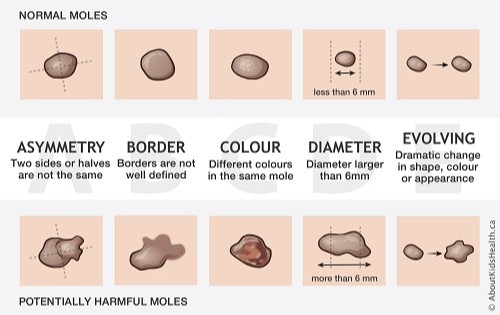 Compared to freckles, lentigines are darker and less common; moreover, their color does not increase and the number does not increase under the influence of solar radiation.
Compared to freckles, lentigines are darker and less common; moreover, their color does not increase and the number does not increase under the influence of solar radiation.
Epidermal-dermal nevi are usually flat, but sometimes slightly elevated above the level of the skin. Coloring from light brown to almost black, sizes – from 1 to 10 mm. Birthmarks on the palms, soles, and genital area are usually epidermal-dermal.
Complex nevi – more often have a dark color due to the accumulation of melanocytes and to some extent rise above the level of the skin.
Intradermal nevi elevated above skin level; their color varies from flesh to black, and the surface may be smooth, hairy, or warty.
Sutton’s nevi are pigmented birthmarks (usually complex and intradermal nevi) surrounded by a ring of depigmented (unstained) skin. Sutton’s nevi disappear spontaneously, and only in rare cases give rise to malignant melanomas.
Dysplastic nevi are pigmented spots of irregular shape and indistinct borders, slightly elevated above the level of the skin, their color varies from reddish-brown to dark brown on a pink background.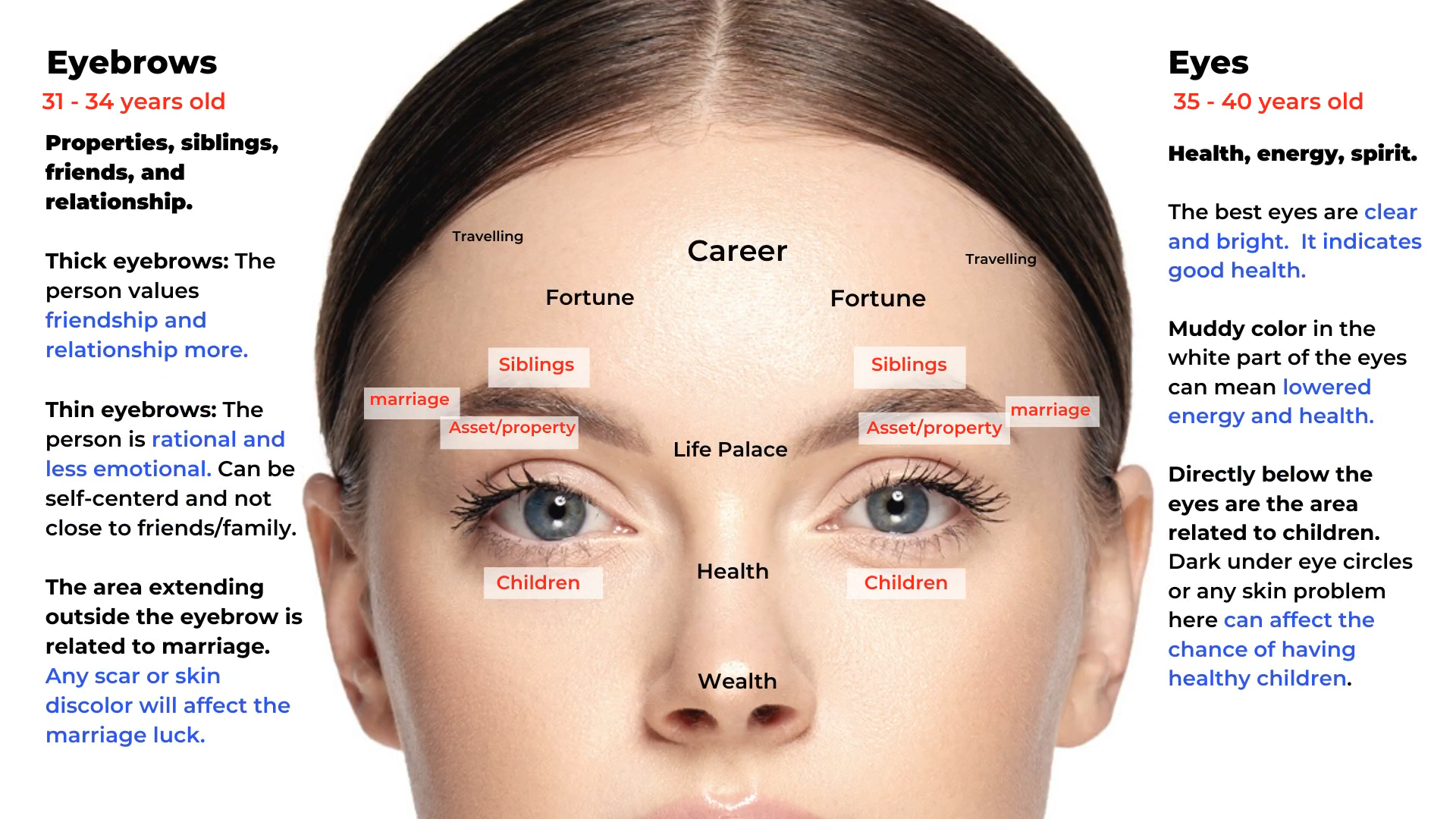

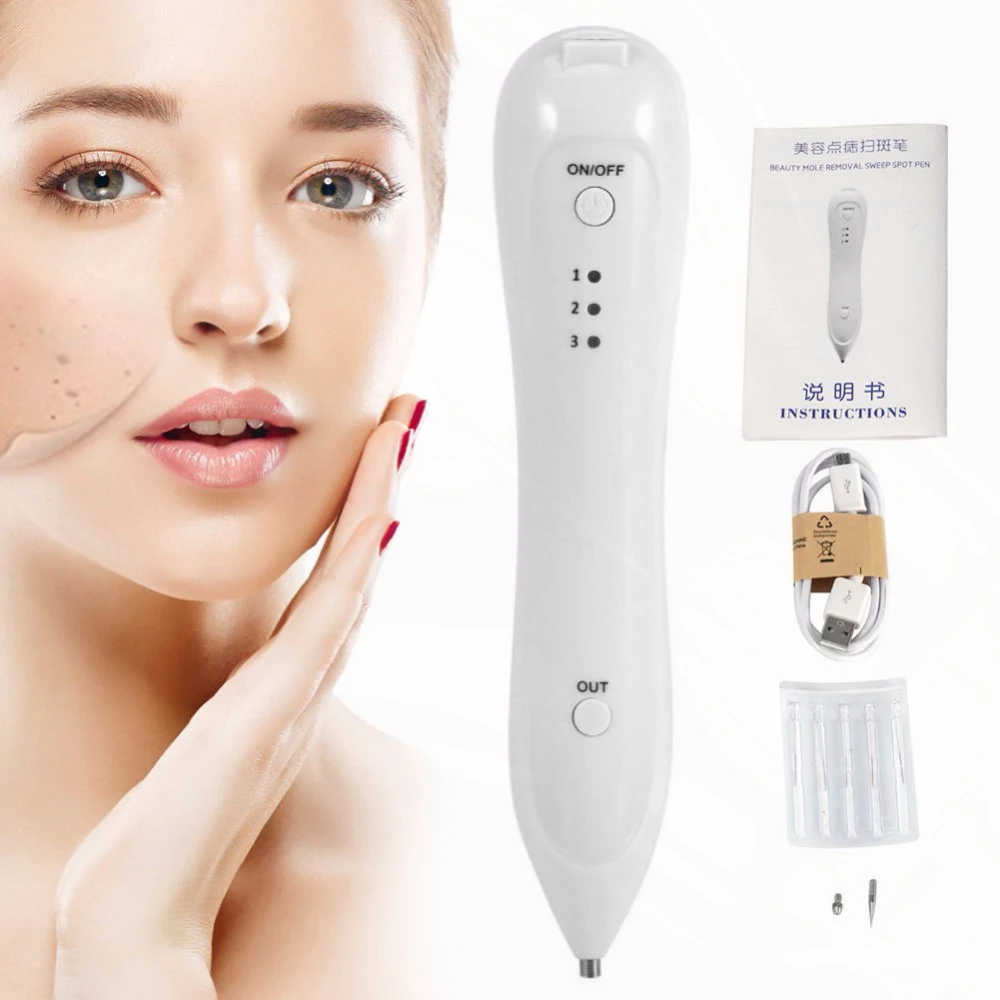 The more atypical moles that you have, the higher your risk of skin cancer.
The more atypical moles that you have, the higher your risk of skin cancer.